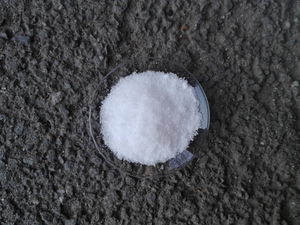Sulfamic acid
 OTC sulfamic acid sample
| |
| Names | |
|---|---|
| IUPAC name
Sulfamic acid
| |
| Systematic IUPAC name
Sulfamic acid | |
| Other names
Amidosulfonic acid
Amidosulfuric acid Aminosulfonic acid Imidosulfonic acid Sulfamidic acid | |
| Properties | |
| H3NSO3 | |
| Molar mass | 97.10 g/mol |
| Appearance | Colorless solid |
| Odor | Odorless |
| Density | 2.15 g/cm3 |
| Melting point | 205 °C (401 °F; 478 K) (decomposes) |
| Boiling point | Decomposes |
| 14.68 g/100 ml (0 °C) 18.56 g/100 ml (10 °C) 21.32 g/100 ml (20 °C) 26.09 g/100 ml (30 °C) 29.49 g/100 ml (40 °C) 32.82 g/100 ml (50 °C) 37.10 g/100 ml (60 °C) 41.91 g/100 ml (70 °C) 47.08 g/100 ml (80 °C) Slow hydrolysis | |
| Solubility | Moderately soluble in ammonia, DMF, formamide Sparingly solubility in methanol, sulfuric acid Insoluble in acetone, acetonitrile, carbon disulfide, carbon tetrachloride, chloroform, DCM, diethyl ether, ethanol, hydrocarbons |
| Solubility in acetone | 0.4 g/100 g[1] |
| Solubility in diethyl ether | 0.009 g/100 g |
| Solubility in formamide | 20 g/100 g |
| Solubility in methanol | 4.3 g/100 g |
| Solubility in sulfuric acid | 2.38 g/100 g |
| Vapor pressure | ~0.06 mmHg (20 °C) |
| Acidity (pKa) | 1.0 |
| Thermochemistry | |
| Hazards | |
| Safety data sheet | Sigma-Aldrich |
| Flash point | Non-flammable |
| Lethal dose or concentration (LD, LC): | |
| LD50 (Median dose)
|
3,160 mg/kg (rat, oral) 1,312 mg/kg (mouse, oral) 1,050 mg/kg (guinea pig, oral) |
| Related compounds | |
| Related compounds
|
Sulfuric acid Sulfamide |
| Except where otherwise noted, data are given for materials in their standard state (at 25 °C [77 °F], 100 kPa). | |
| Infobox references | |
Sulfamic acid, also known as amidosulfonic acid, aminosulfonic acid or sulfamidic acid, is a chemical compound with the formula H3NSO3 or H2NSO3H, a solid strong acid at room.
Contents
Properties
Chemical
Sulfamic acid is a moderately strong acid, Ka = 0.101 (pKa = 0.995).
Aqueous solutions of sulfamic acid are unstable and slowly hydrolyze to ammonium bisulfate, but the crystalline solid is indefinitely stable under ordinary storage conditions.
Sulfamic acid reacts with nitrous acid to give nitrogen, while reaction with nitric acid, it affords nitrous oxide:
- HNO2 + H3NSO3 → H2SO4 + N2 + H2O
- HNO3 + H3NSO3 → H2SO4 + N2O + H2O
Upon heating sulfamic acid will react with alcohols to form the corresponding organosulfates.
Refluxing sulfamic acid with methanol will yield ammonium methyl sulfate, which can be easily converted into methylamine (sulfate) by heating it at high temperatures.[3]
Sulfamic acid melts at 205 °C before decomposing at higher temperatures to water, sulfur trioxide, sulfur dioxide and nitrogen.
- H3NSO3 → H2O + SO3 + SO2 + N2
Physical
Sulfamic acid is a colorless odorless solid acid, soluble in water, but insoluble in organic solvents. Sulfamic acid is not hygroscopic, though finely powdered form may appear "sticky", similar to wet snow in appearance.
Availability
Sulfamic acid is readily available as solid acidic descaling agent, sold in many hardware stores. Sometimes it's sold as coffee machine cleaning powder, though always read the label, as many have producers have replaced it with citric acid.
Preparation
Sulfamic acid is produced industrially by treating urea with a mixture of sulfur trioxide and sulfuric acid (or oleum). The conversion is conducted in two stages:
- (NH2)2CO + SO3 → OC(NH2)(NHSO3H)
- OC(NH2)(NHSO3H) + H2SO4 → CO2 + 2 H3NSO3
Hydrolysis of sulfamide will yield sulfamic acid.
Preparation of sulfamic acid is not something any amateur chemist can do at home, due to the extreme conditions the preparation requires. As such, it's much more economical to simply purchase the compound, as usually it's readily available.
Projects
- Make nitrous oxide
- Make methylamine
- Make sodium cyclamate
- Catalyst for esterification process
- Make ammonium bisulfate
- Make ammonium sulfamate
- Make guanidinium sulfate
- Make ammonium dinitramide
- Coagulator for urea-formaldehyde resins
- Silver polishing
Handling
Safety
Sulfamic acid is irritant and should be handled with care.
Storage
Sulfamic acid is best stored in closed plastic bottles, away from ammonia and moisture.
Disposal
Can be neutralized with an aq. base, then poured down the drain.
References
- ↑ Cupery, M. E.; Industrial and Engineering Chemistry; vol. 30; (1938); p. 627 - 631
- ↑ Patron, M.; Ind. chim.; vol. 42; (1955); p. 237 - 243
- ↑ Making Ammonium Methyl Sulfate